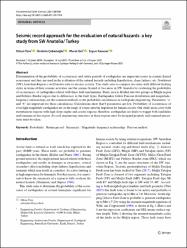Seismic record approach for the evaluation of natural hazards: a key study from SW Anatolia/ Turkey
Künye
Türe O, Çobanoğlu İ, Gül M, Karacan E (2021) Seismic record approach for the evaluation of natural hazards: a key study from SW Anatolia/ Turkey. Environmental Earth Sciences. doi: 10.1007/s12665-021-09779-0Özet
Determination of the probability of occurrences and return periods of earthquakes are important issues in seismic hazard assessment and they are used in the evaluation of the natural hazards including liquefaction, slope failures, etc. Southwest (SW) Anatolian Region is well known with its seismic activity. This study aims to compare two areas with different faulting styles in terms of their seismic activities and the seismic hazard of two areas in SW Anatolia by evaluating the probability of occurrences, of earthquakes related with these fault mechanisms. Study area is divided into two groups as Mugla region and Fethiye-Burdur region due to differences in the fault types. Earthquakes follow Poisson distribution and magnitude-frequency relationships are the common methods in the probability calculations in earthquake engineering. Parameters "a" and "b" are important for these calculations. Calculations show that b parameters are low. Probability of occurrences of even high-magnitude earthquakes are in the range of a time interval important for human society. Our study areas cover both mountainous regions with high slope angles and coastal regions; therefore, earthquakes are likely to trigger both landslides and tsunamis in this region. So civil engineering structures in these regions must be designed properly and required precautions must be taken.


















